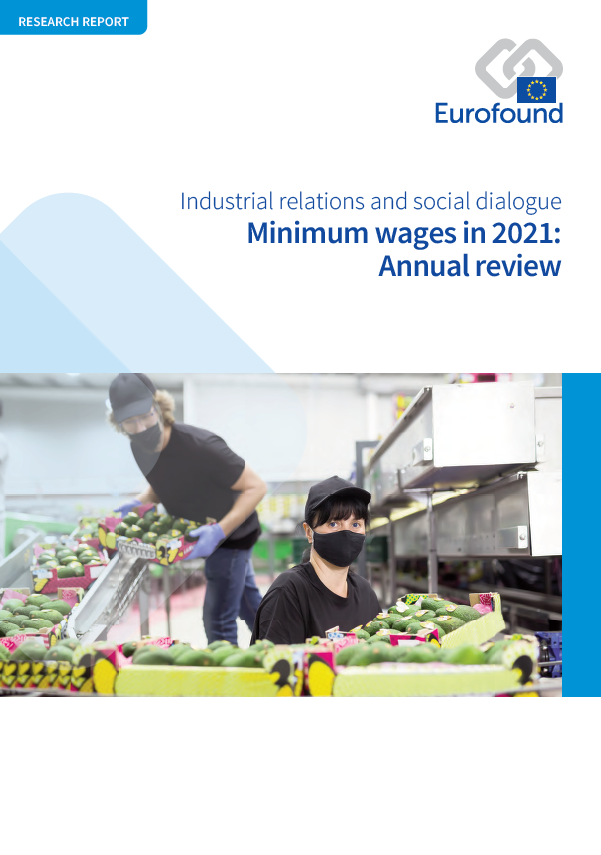
V tem poročilu je povzeto, kako so bile med letom 2020, ki ga je zaznamovala pandemija bolezni COVID-19, določene stopnje minimalne plače za leto 2021. Predstavljene so težave, s katerimi so se srečevali državni nosilci odločanja, ter njihovi odzivi na izzive odpravljanja gospodarskih in socialnih posledic pandemije pri sprejemanju odločitev v zvezi z minimalno plačo. Opisan je obseg, v katerem so bile obravnavane minimalne plače pri podpornih ukrepih, povezanih s pandemijo bolezni COVID-19. Poročilo obravnava napredek v zvezi s pobudo EU o ustreznih minimalnih plačah ter opisuje odzive socialnih partnerjev na ravni EU in državnih nosilcev odločanja. Poročilu sta priložena dopolnilna delovna dokumenta: prvi zajema analizo razvoja dogodkov za slabše plačane zaposlene in delavce z minimalno plačo v zadnjem desetletju, drugi pa povzema najnovejšo raziskavo glede minimalnih plač v državah EU, na Norveškem in v Združenem kraljestvu.
Key findings
Minimalne plače so se od leta 2020 do leta 2021 v večini držav članic rahlo dvignile, povprečje na državo pa je znašalo 3 % (izračunano v državnih valutah). Samo nekatere države članice so se odločile, da v letu 2021 zamrznejo višino minimalne plače. Tokrat so se države članice odzvale precej drugače kot med finančno krizo.
V državah brez zakonsko določenih minimalnih plač (Avstrija, Danska, Finska, Italija, Švedska in Norveška) je bilo povišanje plač zmerno, toda v splošnem so se pogajanja izkazala za razmeroma stabilna. Ker je pandemija v nekaj primerih vplivala na kolektivna pogajanja, so bila nekatera podaljšanja pogodb ali povišanja plač preložena.
Glavni izziv, s katerim so se državni nosilci odločanja v letu 2020 spoprijemali med določanjem minimalnih plač, je bila splošna gospodarska negotovost zaradi pandemije. Napovedi so bile, kadar je bilo to mogoče, bolj negotove oziroma nestanovitne kot običajno.
Stališča socialnih partnerjev o predlagani direktivi EU o minimalnih plačah ostajajo nespremenjena. V splošnem so najbolj kritične organizacije delodajalcev, ki bi imele raje nezavezujoče priporočilo. Večina sindikatov pobudo podpira, vendar bi želeli iti še korak naprej. Stališča vlad so različna.
List of tables
The report has the following list of tables:
Table 1: Gross minimum wages, selected EU Member States and the UK, in € and national currencies, 2020 and 2021 compared
Table 2: Sub-minimum rates for selected EU Member States and the UK as of January 2021
Table 3: Occupational or sector-related statutory minimum wage rates in Cyprus, Malta and Romania, January 2021
Table 4: Seniority- or qualification-related top-ups of statutory minimum wage rates for private sector workers, January 2021
Table 5: Minimum wage rates related to level of hardship or job demands for private sector workers, January 2021
Table 6: Change in monthly minimum wages in collective agreements (%), between 1 January 2020 and 1 January 2021, for selected low-paid jobs (national currencies)
Table 7: Minimum wage setting for 2021 – Countries that followed previous commitments
Table 8: Minimum wage setting for 2021 – Countries that adhered to formulas
Table 9: Minimum wage setting for 2021 – Countries that fell short of previous targets
Table 10: Minimum wage setting for 2021 – Countries that opted for cautious increases
Table 11: Minimum wage setting for 2021 – Countries that froze the level or deferred decisions
Table 12: Change in the number of employees 2019 to 2020 and proportion of minimum wage workers, by sector
Table A1: Legal basis for statutory minimum wages
Table A2: Overview of changes to minimum wage regulations in 2020
Table A3: Wage rates in collective agreements related to 10 selected low-paid jobs, 2020 to 2021, in national currency
Table A4: Minimum wage references used in short-time working schemes or for subsidised employment
Table A5: References to the minimum wage determining the eligibility for income support when employed
Table A6: Minimum wage references used to determine the level of COVID-19-related benefits for self-employed people, working parents and others
Table A7: References to the minimum wage determining the eligibility to obtain certain benefits
Table A8: List of other COVID-19 EU PolicyWatch database cases referred to in this report by country
Table A9: Network of Eurofound Correspondents
List of figures
The report has the following list of figures:
Figure 1: Breakdown of national decision-makers interviewed, based on organisation type and system type (%)
Figure 2: Hourly minimum wages (€), selected Member States, 2021
Figure 3: Collectively agreed average or median monthly pay in 10 low-paid jobs, January 2021 (€)
Figure 4: Minimum wage setting for 2021 and the role of the social partners
Figure 5: Change in number of employees between 2019 and 2020 and proportion of minimum wage workers by occupation, men and women
Figure 6: Stances towards the proposed directive by respondent type (%)
Figure 7: Stances towards the proposed directive by type of wage setting (%)
- Number of pages
-
74
- Reference nº
-
EF21015
- ISBN
-
978-92-897-2172-1
- Catalogue nº
-
TJ-AS-21-001-EN-N
- DOI
-
10.2806/47491
- Permalink
Cite this publication
Eurofound (2021), Minimum wages in 2021: Annual review, Minimum wages in the EU series, Publications Office of the European Union, Luxembourg.
